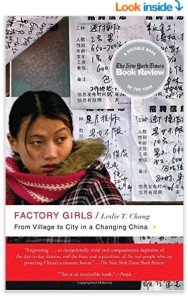“U.S. Presses China to Free Activists Scrutinizing Ivanka Trump Shoe Factory,” (New York Times, June 6, 2017) reports on labor activists detained by Chinese authorities and U.S. State Department pressure for their release. U.S. firms purchasing shoes, clothes, and other goods made in China employ third-party certification agencies to insure working conditions are adequate.
“How Big Brands Can Cultivate Ethical Suppliers” (Stanford Business Insights, October 31, 2016) notes:
Managing risky suppliers requires the use of multiple tools, Lee says. One is certification — which entails paying a third party to visit the factory and determine whether it meets established quality-management and worker safety standards. Lee cautions, however, that suppliers can temporarily improve conditions to pass the certification, then revert to unsafe practices after inspectors leave.
Another tool is an audit, which is a more in-depth investigation done by a third party, typically performed annually. Lee’s research found that these audits are not to be taken lightly. “If you spend more money, you get more accuracy,” he says. …
Working conditions, hours, and wages across China’s vast manufacturing centers can look tragic to western eyes. Trading Economics reports wage increases for 2016, with one Chinese Yuan equalling 15 cents:
Wages in Manufacturing in China increased to 59470 CNY/Year in 2016 from 55324 CNY/Year in 2015.
So average annual factory wages rose to $8.920 from $8,299. A bar chart shows the astonishing increase in average factory wage rates, with: 41650 CNY ($6,247) in 2012, 26559 CNY ($3,983) in 2009.
Factory Girls: From Village to City in a Changing China, was published in 2009, so it’s sobering stories were of young migrant women working long hours early well below 2009 average wages. The U.S. bureau of labor statistics calculates average Chinese factory wages at $1.60 an hour in 2009.
So it’s good news that average factory wages have more than doubled from 2009 to 2016. But The Washington Post, in “Workers endured long hours, low pay at Chinese factory used by Ivanka Trump’s clothing-maker,” (April 25, 2017) reports wages of just $1 an hour (60 hours to earn $62):
Workers at a factory in China used by the company that makes clothing for Ivanka Trump’s fashion line and other brands worked nearly 60 hours a week to earn wages of little more than $62 a week, according to a factory audit released Monday.
The article reports monthly wages about half current national averages:
The factory’s workers made between 1,879 and 2,088 yuan a month, or roughly $255 to $283, which would be below minimum wage in some parts of China. The average manufacturing employee in urban China made twice as much money as the factory’s workers, or roughly 4,280 yuan a month, according to national data from 2014.
Wages reflect productivity, and as a workers from rural China gain manufacturing skills their pay increases. They transition to more valuable work with higher wages, often by moving to other firms. Factories cutting and assembling shoes, especially low-volume, high-fashion shoes seem slow to adopt automated assembly. In response, many labor-intensive factories are shifting production to countries with larger pools of low-skill, low-wage workers:
Many manufacturers, especially those in the garment, shoe and toy industries, have already relocated from China to smaller Asian countries such as Bangladesh, Cambodia and Vietnam, in many cases replicating the pay and working conditions seen in China a decade ago. (China Labor Bulletin, “Wages & Employment)
The China Labor Bulletin article notes that the low wages, as in the Ivanka Trump supplier, are not unusual for Chinese factories with migrant labor:
The average take-home pay of migrant workers, who are among China’s lowest paid, is often less than half the overall average wage in China’s major cities. A 2015 survey of rural migrant workers showed that their average monthly wage was just 3,072 yuan. The highest-paid sectors for migrant workers were transport and logistics (3,553 yuan per month) and construction (3,508 yuan per month), while those employed in household services, sales, hotel and catering services were the lowest paid, earning just over 2,600 yuan per month.
Leslie Chang, the author of Factory Girls: From Village to City in a Changing China helps put these very low wages in context in her 2012 TED talk (below). Chinese factory conditions and wages are usually a significant improvement from life in the rural villages workers migrate from.
https://www.ted.com/talks/leslie_t_chang_the_voices_of_china_s_workers
The Naked Capitalism post “The voices of China’s workers,” (October 16, 2012) has Chang’s TED presentation, and quotes from the transcript discussing how factory workers (again, at 2009 migrant wages) saw their work and opportunities:
[CHANG:] … All of these speakers, by the way, are young women 18 or 19 years old. So I spent two years getting to know assembly line workers like these in the South China factory city called Dong Wan [phonetic]. Certain subjects came up over and over: How much money they made; what kind of husband they hoped to marry; whether they should jump to another factory, or stay where they were. Other subjects came up almost never, including living conditions that to me looked close to prison life. Ten or fifteen workers in one room, 50 people sharing a single bathroom, days and nights ruled by the factory clock. Everyone they knew lived in similar circumstances, and it was still better than the dormitories and homes of rural China.
The post’s comments include a heated debate over Chang’s talk and the ethics of wages and conditions for Chinese workers making goods for U.S. consumers.
